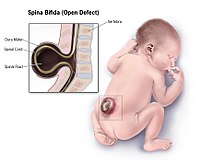
Photo from wikipedia
OBJECTIVE Despite in utero spina bifida (SB) repair, more than two-thirds of patients with SB are unable to ambulate independently, and 1 in 4 children need surgery for tethered cord… Click to show full abstract
OBJECTIVE Despite in utero spina bifida (SB) repair, more than two-thirds of patients with SB are unable to ambulate independently, and 1 in 4 children need surgery for tethered cord by school age. The objective of this study was to test the cryopreserved human umbilical cord (HUC) as an antiscarring material to reduce tethering and improve function in a modified in utero SB repair model. METHODS An SB defect (L2-6 levels) without myelotomy was created in fetuses of timed-pregnant ewes at gestational day (GD) 75. On GD 96, the fetal defect was exposed, and the arachnoid layer was removed to disrupt the barrier and expose the spinal cord to simulate human in utero SB repair. The fetuses were randomly assigned to two groups according to the method used to cover the spinal cord: the conventional repair (CR) group, for which myofascial closure was used (n = 7), and the HUC meningeal patch group, for which HUC was used as a meningeal patch (n = 6), followed by primary skin closure. The lambs were delivered at GD 140. Blinded clinical assessment of spinal cord function was performed using the Texas Spinal Cord Injury Scale (TSCIS). Histology of the spine was performed for quantitative assessment of spinal cord tethering, inflammatory markers, and arachnoid layer regeneration. RESULTS The TSCIS scores were significantly lower in the CR than the HUC meningeal patch group (p = 0.0015) and the controls (p = 0.0018). The loss of spinal cord function in the CR group was mainly due to ataxia and loss of proprioception (p = 0.01 and 0.005 vs control and HUC, respectively). The histology at the repair site showed higher rates of spinal cord tethering in the CR lambs than the HUC lambs at all levels of the repair site (p = 0.01 and 0.02 vs control and HUC, respectively). In the CR with tethering compared with the HUC repair, there was a lower arachnoid layer covering at the repair site (p = 0.001). There was greater astrocyte activation in the posterior column in the CR than in the HUC repair group (p = 0.01). CONCLUSIONS In a modified ovine SB model, the HUC as a meningeal patch allows regeneration of the arachnoid layer, prevents spinal cord tethering, and improves spinal cord function after in utero SB repair.
Journal Title: Journal of neurosurgery
Year Published: 2023
Link to full text (if available)
Share on Social Media: Sign Up to like & get
recommendations!